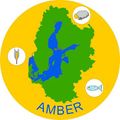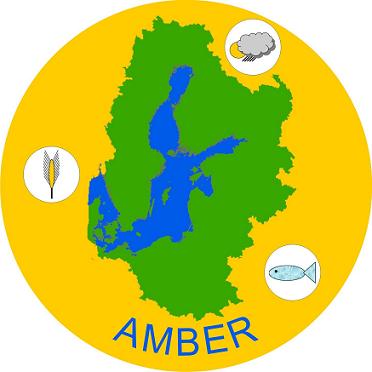File:AmberLogo.JPG
The main aim of AMBER is to implement and to adapt an "Ecosystem Approach to Management (EAM)" with focus on the coastal ecosystem of the Baltic Sea. Therefore, and for an optimal integrated management, it is important to the coastal system with a holistic approach to investigate. The interdependence between the catchment and the groundwater on the one hand and the open Baltic Sea, on the other hand, is of great importance as a central topic of research. Furthermore, it is important how they affect climate change and land use change in the composition of river water and the biogeochemistry of coastal waters and the sediments.
One of the first steps of AMBER is the separation of climate signals and anthropogenic signals by combinatorial variation of the constraints of the model, whereupon the output of existing regional climate models and the output of models of the catchment area that simulate the change in land use are available. To implement an EAM strategy, the best scientific information as a basis for integrated management is needed. For this reason, a retrospective data analysis, an intensive modeling with different types of models, and selected measurements of biogeochemical transformation processes in the coastal waters and groundwater is necessary. Another goal is the projection on the 21 Century. In order to reduce the problem of model uncertainty, the ensemble method is used.
The main goals of AMBER will be:
a. qualitative risk assessments for various climate scenarios, land uses and life style change scenarios
b. derivation of mitigation of the risk assessment. Mitigation strategies are necessary tools for integrated management
c. development of the "Ecological Quality Objectives" (EcoQOs) to apply the EAM following the guidance of the ICES (2005). EcoQOs are the basis for
d. the development of indicators, limits and goals. These quantitatively describe the condition of the ecosystem, ecosystem properties or impacts. Finally, cost-effective indicators will be developed to improve monitoring strategies and to guide environmental management in decision making.
EAM with its tools risk assessment, mitigation strategies, derivation of EcoQOs and improvement of monitoring strategies will be the core of science based advice for integrated management. AMBER contributes to the objectives of BALTEX.
File history
Click on a date/time to view the file as it appeared at that time.
| Date/Time | Thumbnail | Dimensions | User | Comment | |
|---|---|---|---|---|---|
| current | 09:18, 16 August 2011 |  | 372 × 372 (17 KB) | SSchumacher (talk | contribs) | |
| 09:06, 16 August 2011 |  | 1,456 × 1,456 (102 KB) | SSchumacher (talk | contribs) | The main aim of AMBER is to implement and to adapt an "Ecosystem Approach to Management (EAM)" with focus on the coastal ecosystem of the Baltic Sea. Therefore, and for an optimal integrated management, it is important to the coastal system with a holisti |
- You cannot overwrite this file.
File usage
There are no pages that link to this file.
